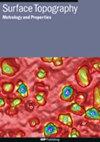Research on self-healing characteristic and state prediction method of the copper based powder metallurgy materials on friction interface
IF 2
3区 材料科学
Q2 ENGINEERING, MECHANICAL
引用次数: 0
Abstract
In high power density transmission systems, the friction and wear characteristic of copper based powder metallurgy materials is directly linked to working reliability. Moreover, these materials have frictional self-healing characteristic at the material interface. This paper focuses on exploring the healing mechanism of copper based powder metallurgy materials and conducts ‘damage-healing’ tests, proposing a method to characterize the self-healing characteristic. Subsequently, through comparative tests, the influence of temperature, speed, and pressure on the self-healing characteristics is analyzed. The results show that the increase in temperature reduces the furrow width and depth by 15.30% and 59.76%, respectively. Pressure has the greatest effect on surface roughness, reducing it by 67%. Meanwhile, this paper developed a PSO (Particle Swarm Optimization)-LSTM (Long Short-Term Memory) method to accurately predict the self-healing characterization parameters and self-healing time with small error (average 4.35%) and high correlation coefficient (摩擦界面铜基粉末冶金材料的自修复特性及状态预测方法研究
在高功率密度传动系统中,铜基粉末冶金材料的摩擦和磨损特性直接关系到工作可靠性。此外,这些材料在材料界面上具有摩擦自愈合特性。本文重点探讨了铜基粉末冶金材料的愈合机理,并进行了 "损伤愈合 "试验,提出了表征自愈合特性的方法。随后,通过对比试验,分析了温度、速度和压力对自愈合特性的影响。结果表明,温度升高会使沟宽和沟深分别减少 15.30% 和 59.76%。压力对表面粗糙度的影响最大,降低了 67%。同时,本文开发了一种 PSO(粒子群优化)-LSTM(长短期记忆)方法,可准确预测自愈表征参数和自愈时间,误差小(平均为 4.35%),相关系数(R2)高(平均为 0.976)。这项研究有助于摩擦材料界面修复技术的发展。
本文章由计算机程序翻译,如有差异,请以英文原文为准。
求助全文
约1分钟内获得全文
求助全文
来源期刊

Surface Topography: Metrology and Properties
Materials Science-Materials Chemistry
CiteScore
4.10
自引率
22.20%
发文量
183
期刊介绍:
An international forum for academics, industrialists and engineers to publish the latest research in surface topography measurement and characterisation, instrumentation development and the properties of surfaces.
 求助内容:
求助内容: 应助结果提醒方式:
应助结果提醒方式:


